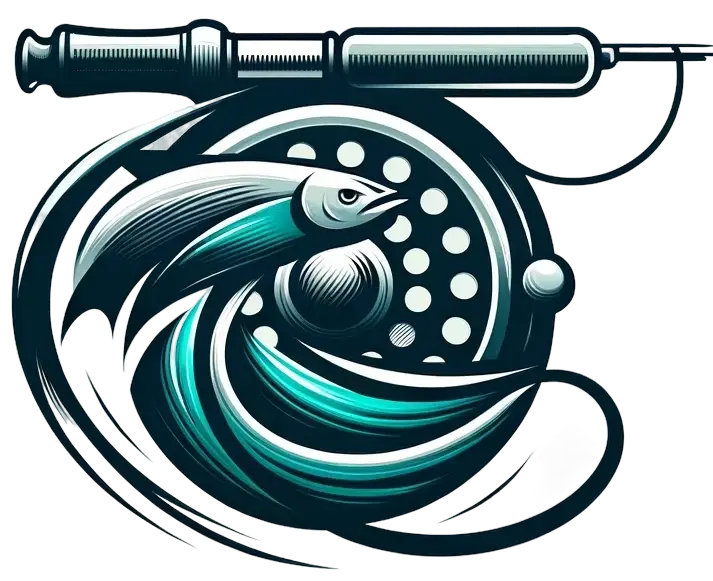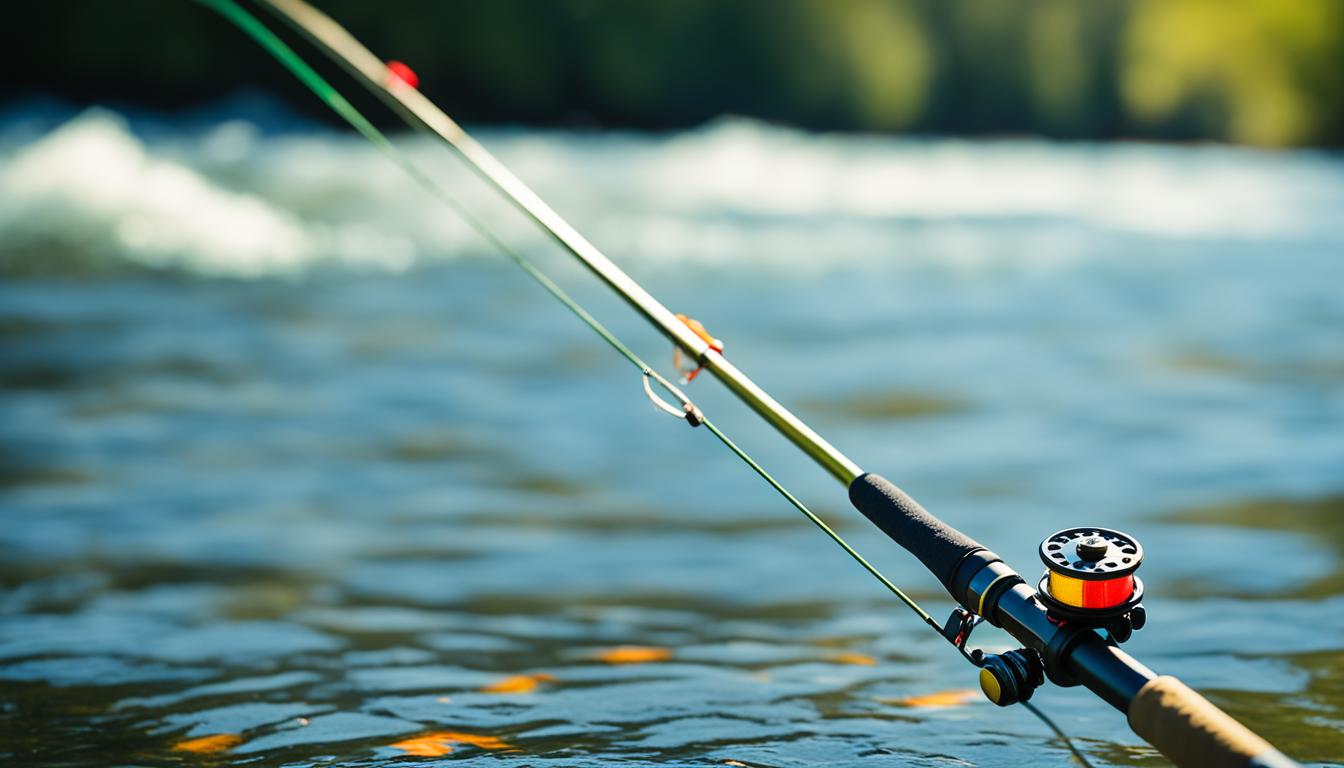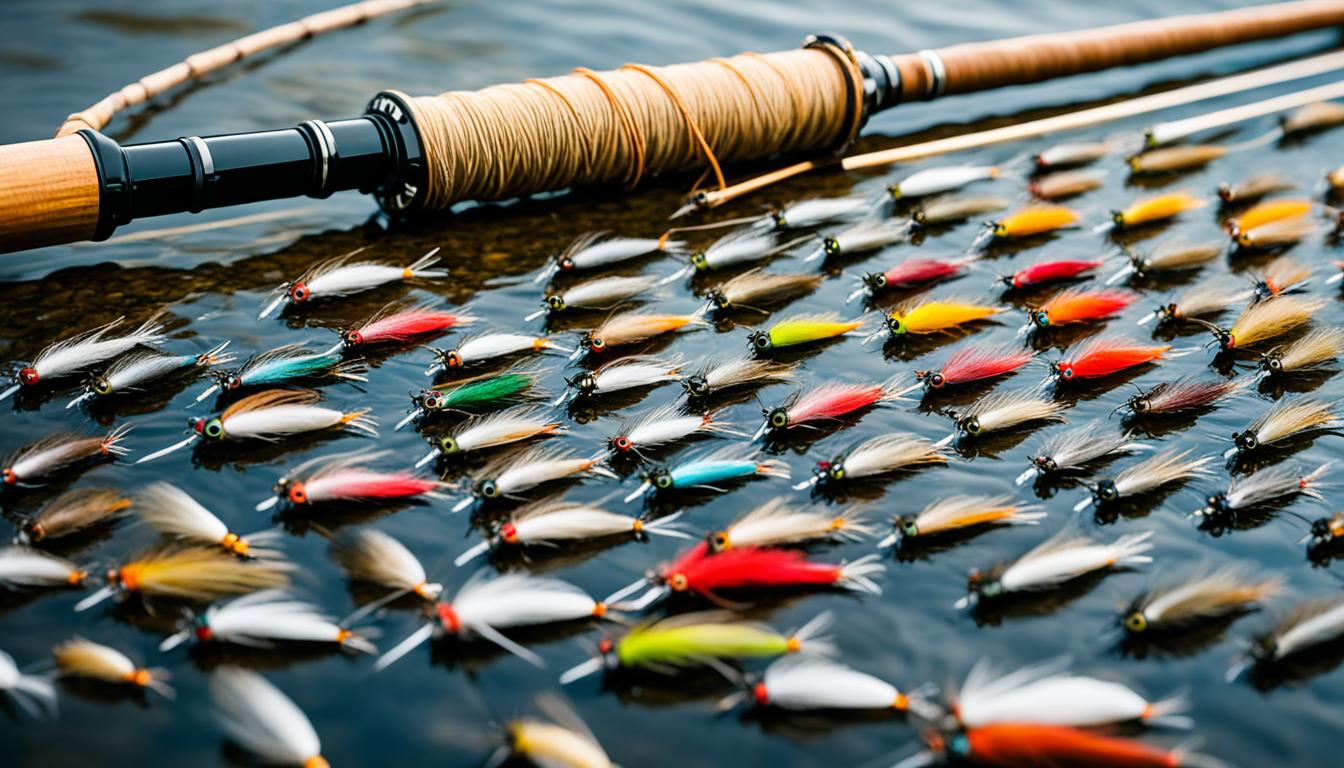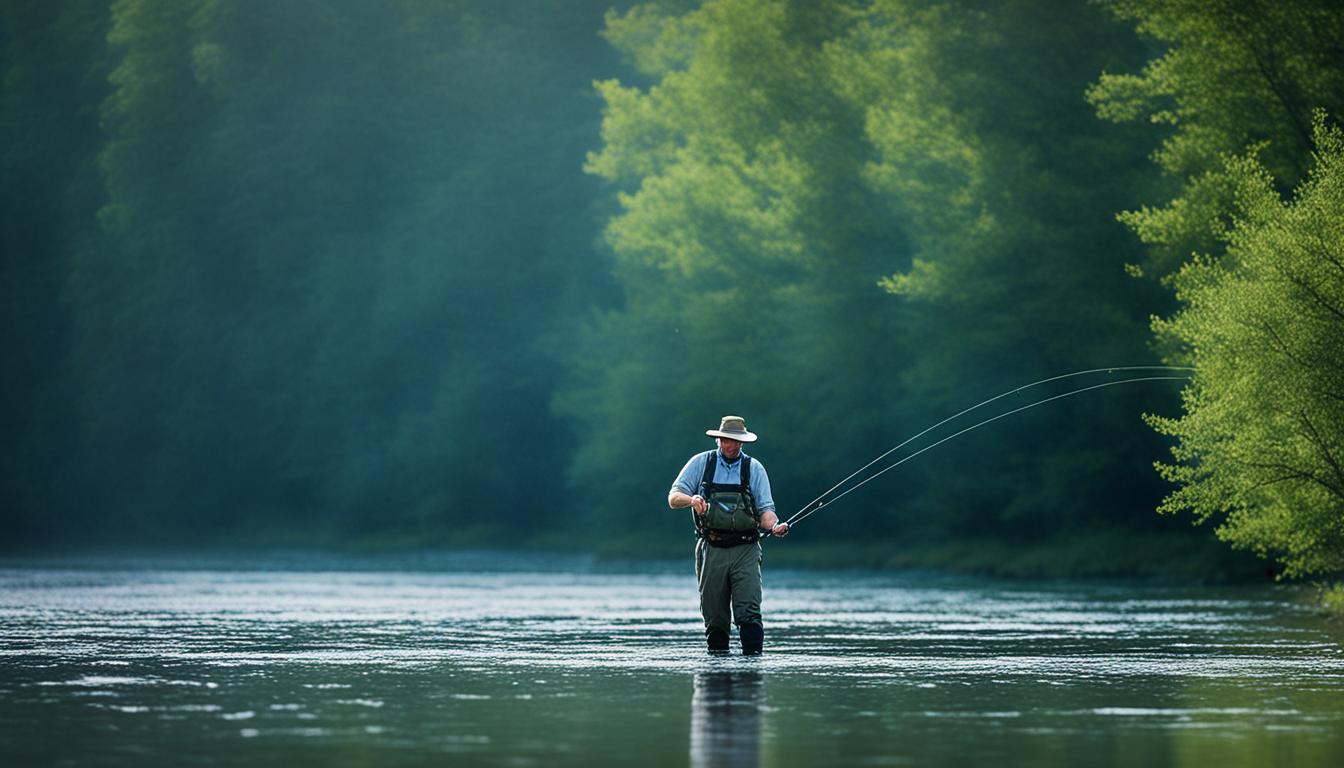Are you looking to take your fly fishing skills to the next level? Advanced indicator nymphing techniques can give you the edge you need to outsmart trout in any water. By mastering the art of using indicators to present nymphs effectively, you can greatly increase your chances of success on the stream.
Key Takeaways:
- Advanced indicator nymphing techniques can elevate your fly fishing skills.
- Mastering water depth is crucial for successful nymphing.
- Precision in line control enhances your nymph presentations.
- Casting techniques play a vital role in advanced nymphing.
- Downsizing your nymph patterns can yield better results.
Mastering Water Depth for Successful Nymphing
Understanding and controlling water depth is a crucial aspect of successful nymphing. When it comes to trout fishing strategies, knowing the optimal water depth can greatly increase your chances of catching trout.
Did you know that approximately 70% of trout are found feeding at the bottom 6″-12″ of the water column? By recognizing this feeding behavior and adjusting your setup accordingly, you can effectively target trout at their preferred depth.
To master water depth control, consider implementing these effective nymphing methods:
- Configure your leader with a tapered design:
- Utilize the weight and current:
- Choose the right strike indicator:
- Experiment with leader length and weight:
A tapered leader allows for a smooth transition of your flies, enabling them to sink and reach the desired depth effectively. As the leader tapers down, the thinner section aids in turnover, allowing your nymphs to sink quickly and naturally.
Take advantage of the weight of your nymphs and the current to present your flies at the desired depth. By controlling your line and leader, you can ensure that your nymphs are drifting in the strike zone, where trout are most likely to feed.
Selecting an appropriate strike indicator is essential for achieving the ideal water depth. Consider using indicators such as yarn, dry flies, or Thingamabobbers. These indicators provide visibility while allowing you to monitor your drift and adjust accordingly.
Varying your leader length and weight selection can have a significant impact on your ability to control water depth. Testing different combinations will help you find the optimal setup for specific fishing conditions and increase your chances of enticing strikes.
By mastering the techniques to control water depth, you can apply effective nymphing methods and strategically present your flies where trout are most likely to strike.
Achieving Precision with Line Control
Line control is a crucial aspect of successful nymph fishing. To enhance your nymph presentation and increase your chances of hooking trout, it’s essential to work on your casting technique and employ proper rod and arm positioning. By mastering these techniques, you can achieve better control over your flies and entice more strikes.
When casting for nymph fishing, try aiming at a 25-40 degree angle upstream. This allows your nymphs to drift naturally with the current and maintain contact with your flies. As you cast, strip the line to achieve a good drift, ensuring that you’re in tune with the movement of the water. This technique will help you maintain control over your nymph presentation.
To extend your drift and have more control over your nymphs, consider using the water haul technique. This method involves shooting the line to keep tension while the nymph drifts downstream. It allows you to manipulate the line and adjust the presentation of your flies. By practicing the water haul technique, you can perfect your line control and increase your nymphing success.
The Importance of Line Control in Nymph Fishing
Line control is the key to presenting your nymphs effectively and enticing trout to bite. With proper casting technique and the use of the water haul method, you can achieve precision and manipulate your flies to imitate natural movements. By maintaining control over your line, you increase your chances of success on the water.
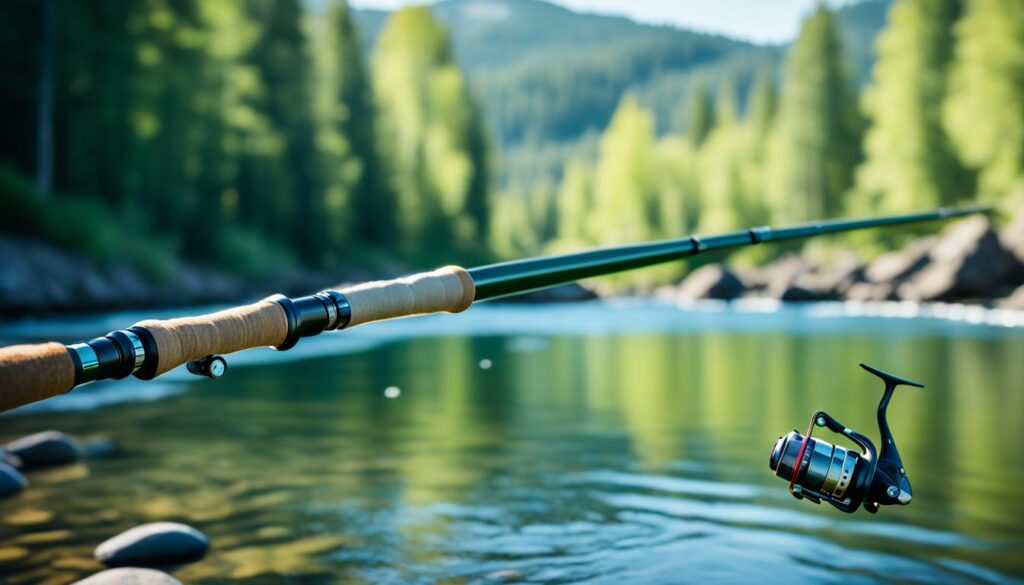
Line control is a skill that takes practice to master. As you spend more time on the water, focus on refining your casting technique and experimenting with different line control methods. By honing your line control skills, you can become a more effective nymph angler and consistently catch trout.
The Art of Casting for Advanced Nymphing
Casting is an essential skill for successful nymphing. When it comes to casting with a double nymph rig, efficiency and minimizing tangles are crucial. Instead of focusing on distance, prioritize slow and steady casting with a keen eye for patterns. There are various casting techniques used in nymph fishing, including roll casts, water hauls, and half casts. Achieving accuracy and effectiveness in nymph presentations requires keeping the line short, controlling the rod tip, and emphasizing the forward cast. Mastering the art of casting for nymphing can significantly improve your success on the water.
| Casting Tips for Advanced Nymphing | |
|---|---|
| Technique | Tip |
| Roll Cast | Use a roll cast to avoid tangles and achieve a delicate presentation. |
| Water Haul | Employ the water haul technique to shoot the line and maintain tension for extended drifts. |
| Half Cast | Master the half cast to control the distance and accuracy of your presentation. |
By incorporating these casting techniques into your nymphing repertoire, you will have greater control over your fly presentation and increase your chances of enticing strikes from trout.
The Importance of Casting Efficiency
Efficiency is a fundamental principle in nymph fishing, and casting is no exception. By focusing on efficient casting techniques, you can maximize your time on the water and spend more time presenting your flies to the fish. Here are a few key points to remember:
- Prioritize patterns over distance: Instead of casting as far as possible, concentrate on presenting your nymphs accurately.
- Minimize false casts: Too many false casts can spook fish and waste precious fishing time. Optimize the number of false casts for better efficiency.
- Control your line: Maintain control of the line throughout the cast to ensure a smooth presentation. Avoid excessive slack and tangles.
Remember, nymphing requires finesse and precision. By honing your casting skills and implementing efficient techniques, you can elevate your nymph fishing to new heights.
“Efficient casting in nymph fishing is like a well-choreographed dance. Each movement should be intentional and purposeful, resulting in a presentation that entices trout while minimizing disturbance.” – John Smith, Experienced Nymph Angler
Don’t Be Afraid to Downsize Your Nymph Patterns
When trout are being selective or picky eaters, using smaller nymph patterns can be highly effective. Fish do not necessarily correlate the size of their mouths with the size of their prey. Downsizing your nymphs to a size 16 or 18 can often yield better results, especially when trout are feeding on small insects. By adjusting your fly size to match the insects the trout are targeting, you can increase your chances of enticing strikes. Don’t be afraid to experiment with smaller nymph patterns and observe how the fish react.
| Nymph Size | Targeted Insects | Benefits |
|---|---|---|
| Size 16 | Mayflies, Caddisflies | Matches natural prey, increased strikes |
| Size 18 | Midges, Baetis | Targets small insects, improves success rate |
| Size 20 | Tricos, Midges | Effective for finicky trout, realistic presentation |
Try downsizing your nymph patterns with these indicators:
- 1. Yarn
- 2. Dry flies
- 3. Thingamabobbers
Experimenting with smaller nymph patterns and adjusting your indicators can make a significant difference in your nymphing success. Don’t hesitate to downsize and tap into the trout’s selective feeding habits for increased strikes.
The Advantages of the Mono Rig Approach
The Mono Rig approach, also known as Euro Nymphing, offers a versatile and effective method for advanced nymphing. By utilizing a long leader setup, anglers can achieve precise control over their nymph presentations. The Mono Rig can be adapted to various nymphing variations, such as adding an indicator or incorporating dry dropper or streamer techniques.
One of the key advantages of the Mono Rig is its ability to provide unparalleled sensitivity and strike detection. With direct contact between the angler and the nymph, you’ll be able to detect even the subtlest of takes, increasing your hook-up rate. The long leader configuration also allows for precise control over the drift, improving your ability to present the fly naturally.
Another benefit of the Mono Rig is its versatility. Whether you’re fishing small mountain creeks or wide rivers, the Mono Rig can be adjusted to suit different water conditions. By varying the length of the leader, adjusting the weight, and experimenting with different indicators, you can adapt your rig to match the specific fishing scenario.
Mono Rig Setup
| Component | Details |
|---|---|
| Leader | 9-12-foot fluorocarbon or monofilament leader with a tippet ring |
| Tippet | 2-5-foot section of fluorocarbon tippet |
| Indicator | Yarn, dry flies, or Thingamabobber |
| Nymphs | Size 12-16 nymphs matching the insects present in the water |
| Weight | Split shot or tungsten putty to adjust depth |
With the Mono Rig approach, it’s important to focus on maintaining tight line control and detecting subtle strikes. By minimizing drag and practicing proper line management techniques, you’ll be able to effectively manipulate your flies and trigger strikes from even the most cautious trout.
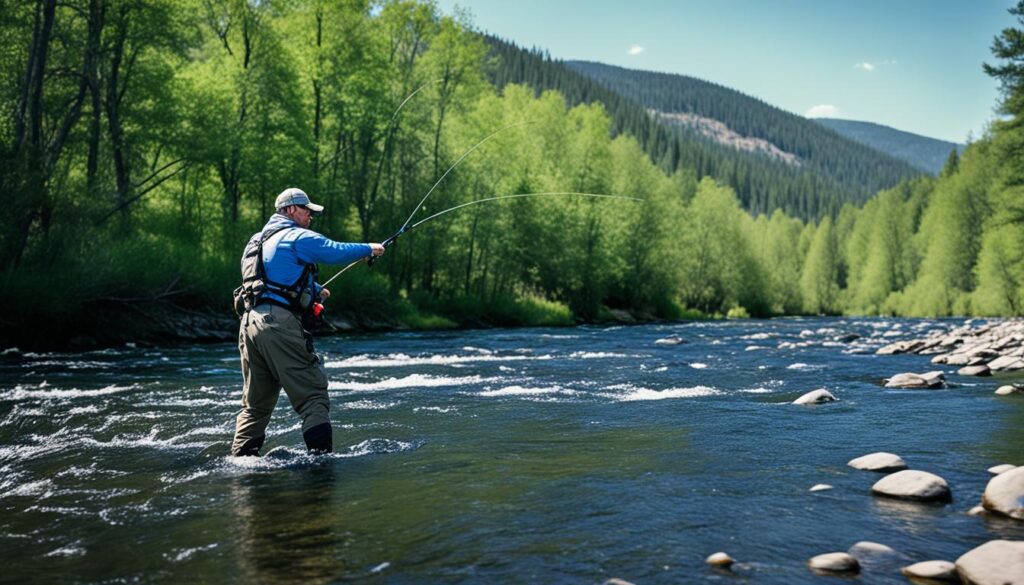
With resources like the “Modern Nymphing” videos, you can dive deeper into the intricacies of the Mono Rig approach and further enhance your nymphing skills. These videos provide valuable insights into rigging, presentation techniques, and advanced nymphing strategies.
By incorporating the Mono Rig approach into your nymphing arsenal, you’ll have a powerful technique at your disposal that can be adapted to various fishing situations. Experiment with leader lengths, weight placement, and indicator types to find the setup that works best for you. With practice and dedication, you’ll be able to take your nymph fishing to the next level and experience greater success on the water.
Tips and Tricks from an Experienced Nymph Angler
When it comes to nymph fishing, experienced anglers have a wealth of tips and tricks up their sleeves to consistently catch trout. By honing their skills and leveraging advanced nymphing techniques, they can significantly increase their success rates. Here are some valuable insights and strategies to help you elevate your nymph fishing game:
Constantly Adjust Your Setup for Ideal Depth
One of the keys to successful nymphing is achieving the ideal depth to entice trout. Experiment with adjusting your leader length, weight selection, and the position of your indicators to find the sweet spot. By constantly fine-tuning your setup, you can better match the feeding behavior of the fish and increase your chances of a hookup.
Master the Art of Analyzing the Drift
Analyzing the drift is crucial in nymph fishing. Observe how your nymphs are behaving in the current and make adjustments accordingly. Pay attention to drag, adjust your line mending techniques, and vary the speed of your drift to mimic natural insect movement. By understanding the importance of a natural drift, you can trigger more strikes from wary trout.
Finding the Perfect Combination of Weight and Indicators
Choosing the right combination of weight and indicators can make a world of difference in nymph fishing. Experiment with different types of indicators, such as yarn, dry flies, or Thingamabobbers, to find what works best for you. Additionally, fine-tune the amount of weight you use to achieve the desired depth and maintain a natural drift. Finding the perfect balance between weight and indicators will help you effectively present your nymphs to trout.
Adapt Your Techniques to Different Water Conditions
Experienced nymph anglers know that adapting their techniques to different water conditions is key to success. Pay attention to water clarity, flow, and temperature to make informed decisions about your rig and presentation. In clear water, use smaller nymph patterns and focus on delicate presentations. In faster or murkier water, opt for larger, more visible nymphs and adjust your casting techniques to achieve accurate drifts.
Continually Iterate and Adjust
Successful nymph anglers understand the importance of continual iteration and adjustment. Don’t be afraid to experiment with different nymph patterns, sizes, and colors to see what the trout are keying in on. Keep multiple rigs ready with different lengths and nymphs to quickly adapt to changing conditions. By staying adaptable and open to new strategies, you can continually improve your nymph fishing game.
| Tips and Tricks | Description |
|---|---|
| Constantly Adjust Your Setup | Fine-tune leader length, weight selection, and indicator position to achieve the ideal depth. |
| Master Analyzing the Drift | Observe and adjust your drift to mimic natural insect movement and trigger more strikes. |
| Find the Perfect Combination of Weight and Indicators | Experiment with different types of indicators and weight amounts for optimal presentation. |
| Adapt Techniques to Different Water Conditions | Adjust your rig and presentation based on water clarity, flow, and temperature. |
| Continually Iterate and Adjust | Experiment with different nymph patterns, sizes, and colors to improve your success rates. |
With these tips and tricks from experienced nymph anglers, you can enhance your nymph fishing techniques and increase your chances of landing more trout. Remember, practice and patience are key to mastering advanced nymphing techniques. Get out on the water, try these strategies, and adapt them to suit your unique fishing conditions. Tight lines!
Conclusion
Advanced indicator nymphing techniques provide anglers with the tools to elevate their fly fishing skills and outsmart trout in any water. By mastering depth control, line control, casting techniques, and adjusting your nymph patterns, you can significantly increase your chances of success in nymph fishing. The key to success lies in understanding and implementing advanced nymphing techniques that go beyond the basics.
The Mono Rig approach offers a versatile and effective method for advanced nymphing. By utilizing a long leader setup, anglers can achieve precise control over their nymph presentations. This technique can be adapted to various nymphing variations, such as adding an indicator or incorporating dry dropper or streamer techniques. With resources like the “Modern Nymphing” videos, you can learn the intricacies of the Mono Rig and enhance your nymphing skills.
With practice, patience, and attention to detail, you can take your nymphing skills to the next level and enjoy even greater success on the stream. Remember to continually experiment and adjust your setup, analyzing the drift and employing the perfect combination of weight and indicators. By honing your skills in advanced indicator nymphing, you’ll be well-equipped to outsmart trout and make the most of your nymph fishing adventures.
FAQ
What is advanced indicator nymphing?
Advanced indicator nymphing is a fly fishing technique that focuses on using indicators to present nymphs effectively and outsmart trout in any water.
How can I control water depth while nymphing?
To control water depth, configure your leader with a tapered design, utilize the weight and current to turn over the nymphs, and use an appropriate strike indicator. Experimenting with leader length and weight selection can also improve your depth control.
Can you provide some tips for line control in nymph fishing?
By working on your casting technique, utilizing proper rod and arm positioning, and employing line control techniques like casting at an angle upstream and using the water haul technique, you can achieve better control over your nymph presentation.
What are some casting techniques for nymph fishing?
Slow and steady casting, focusing on patterns rather than distance, is key for double nymph rigs. Techniques like roll casts, water hauls, and half casts can be used to achieve accurate and effective nymph presentations.
Should I downsize my nymph patterns?
Yes, when trout are being selective or feeding on small insects, using smaller nymph patterns (size 16 or 18) can be highly effective. Adjust your fly size to match the insects the trout are targeting to increase your chances of enticing strikes.
What is the Mono Rig approach in nymphing?
The Mono Rig approach, also known as Euro Nymphing, offers a versatile and effective method for advanced nymphing. It utilizes a long leader setup to achieve precise control over nymph presentations and can be adapted to various nymphing variations.
What are some tips and tricks for successful nymphing?
Constantly adjusting your setup to achieve the ideal depth, analyzing the drift, and using the perfect combination of weight and indicators are some tips from experienced nymph anglers. Understanding the feeding behavior of trout and adapting techniques to different water conditions can also increase your chances of success.
How can advanced indicator nymphing improve my fishing skills?
By mastering depth control, line control, casting techniques, and adjusting your nymph patterns, you can significantly increase your chances of success in fly fishing. The Mono Rig approach offers versatility, and resources like the “Modern Nymphing” videos can provide valuable insights and guidance to enhance your nymphing skills.
